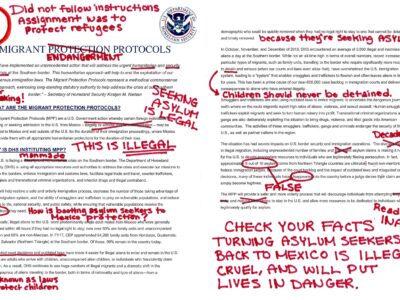Human Rights First Urges Fulfillment of Detention Reform Promises
Says Immigration Detention Facilities Must Shift from Prison Model to Civil Model
Washington, DC – One year after the U.S. Department of Homeland Security (DHS) announced plans for a wide-reaching overhaul of the long-mismanaged immigration detention system, Human Rights First is concerned that the U.S. government has yet to make significant progress toward the underlying goal of detention reform – a true shift from a penal to a civil approach to immigration detention. The group also notes that DHS has taken some important steps to improve the current detention system, but that it still should work toward compliance with detention standards at all facilities. “Last year, DHS made a public commitment to shift the immigration detention model from one based on correctional standards toward a civil model of detention,” said Human Rights First’s Ruthie Epstein. “We welcomed this commitment because detained asylum seekers and other detained immigrants should not be held in prison-like conditions. The purpose of immigration detention is limited to ensuring that detainees show up for their hearings and comply with removal orders. Immigration detention should not be punitive.” The U.S. immigration detention system holds up to 33,400 detainees – including asylum seekers – every day. These detainees are currently held in a sprawling network of approximately 250 facilities (down from 341 a year ago) across the country. Some of these facilities are operated by Immigration & Customs Enforcement (ICE), the enforcement arm of DHS, and others run by private corrections companies or county jail systems. Last year, DHS acknowledged that its detention beds were located in facilities “largely designed for penal, not civil, detention.” Key among its 2009 reform plans was a commitment to shift to a non-penal, or “civil,” model of immigration detention. DHS’s announcement in 2009 came on the heels of two government reports that had concluded that the U.S. immigration system was inappropriately modeled on correctional systems. One was from Dr. Dora Schriro, former Director of the Arizona and Missouri state corrections systems and current Commissioner of Correction for New York City, and the other from the bipartisan U.S. Commission on International Religious Freedom. “ICE has taken some steps to explore new civil detention facility design options and potential improvements in a number of existing facilities, but the real work is just beginning. Thus far, detainees have seen few tangible changes,” added Human Rights First’s Annie Sovcik. “ICE should require changes to be implemented at existing facilities by the end of 2010.” Human Rights First has also encouraged the government to move forward in developing new civil detention standards. Its recommendations for new civil standards and changes to existing facilities include:
- Allowing asylum seekers and other immigrant detainees to wear civilian clothing rather than prison jumpsuits;
- Contact visits with family and friends in all facilities;
- True outdoor recreation space, and expanded access throughout the day; and
- Increased freedom of movement within secure facilities.
In an April 2009 report, U.S. Detention of Asylum Seekers: Seeking Protection, Finding Prison, Human Rights First found that the United States was detaining asylum seekers in penal facilities for months and sometimes years, often without basic safeguards like hearings to assess the need for continued detention. In its report, Human Rights First recommended that the Department of Homeland Security (DHS) stop detaining asylum seekers and other immigrants in penal facilities, and create nationwide alternatives to detention. It also recommended that DHS work with the Department of Justice to provide all detained asylum seekers with access to custody hearings so that the need for their continued detention can be assessed by an immigration court. For more information, see Human Rights First’s background on civil detention here.

